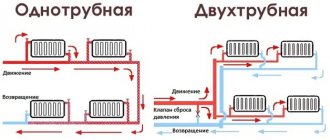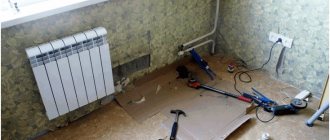Individual apartment heating is a small boiler room in the apartment. The owner of the living space independently regulates the temperature, turns the system on and off at any time of the year. For apartment heating, a boiler, heat metering devices, pipes for gas and smoke exhaust, as well as equipment for air intake are installed. In addition, the heating device is equipped with draft monitoring clamps, flame control, and a shut-off valve, which is activated automatically in the absence of fire.
In modern apartment buildings, individual heating systems are more often installed. But in older apartments there is also the possibility of abandoning central heating and connecting apartment-by-apartment heating.
Where to begin
Let's start with the legal framework. It is necessary to clearly know what the legislation says about disconnecting from the central heating system and installing an individual one. Often the local administration, referring to Art. 190 Federal Law , refuses to residents. In court, such a refusal will be considered unfounded. In Russian legislation, in addition to Federal Law No. 190 “On Heat Supply,” there is Government Decree No. 307 of April 16, 2012, which considers the procedure for connecting heat supply systems. It specifies a list of individual sources of thermal energy that do not meet certain requirements and are for this reason prohibited for installation in apartment buildings.
This means that the law does not prohibit the use of individual heating using modern heating boilers that meet the specified requirements.
This issue has been considered more than once by courts of general jurisdiction. Refusal of local governments based on Art. 14 of the Federal Law “On Heat Supply” is considered illegal.
Required documents
Thus, in order to refuse the central heating service and switch to individual heating, it is necessary to collect a package of documents in accordance with Art. 26 of the Housing Code of the Russian Federation on the reconstruction of residential premises.
The package of documents includes:
- application for reorganization;
- technical passport of the premises;
- title documents for housing (originals or copies certified by a notary);
- residential renovation project,
- consent of all family members, submitted in writing;
- conclusion of the authorities for the protection of architectural monuments on the possibility of reconstructing the premises.
Documentation for gas heating
The management company, after reviewing the application, provides a letter of permission to disconnect your apartment from central heating. This letter is necessary to order technical conditions (TU) for the installation of individual heating. If you plan to connect gas (install a gas boiler), you must contact the gas service.
Technical conditions are issued within ten days. In case of refusal due to lack of “technical possibility”, keep in mind that such a response is only permissible in regions where there is no gas and it is not possible to purchase it in cylinders.
After purchasing a certified boiler, you should contact the design organization. She will prepare a project for installing a boiler, taking into account technical conditions and capabilities.
Then a project is made to disconnect from central heating in the heat supply organization. The basis for this will be a letter from the HOA with permission to disconnect. It is important to receive a written response. In case of disagreement, it will be possible to go to court.
Having received the project documentation, we go with it to the local branch of the All-Russian Voluntary Firefighting Society (VDPO). There you will be given a fire safety certificate for the project. If necessary, a design is made for the chimney.
Then all documentation is approved by the administration. The conclusion on approval (or refusal) is accepted within 45 calendar days. Refusal to renovate the premises occurs on the basis of Art. 27 of the Housing Code of the Russian Federation (case of failure to submit all documents). The refusal can also be appealed in court.
This is the basic diagram of how to prepare a project and legalize the transition to autonomous heating. The list of all documents may differ in different regions. More accurate information will be given to you directly from the administration of your district.
Compliance with the law during installation
The legality of using an autonomous unit to supply heat to a separate apartment gives rise to many disputes. In 2010, disconnection from the general heat supply main was prohibited by the Russian government. The installation of individual complexes for heating rooms in multi-storey buildings is also blacklisted.
But in 2012, a new decree on regulations for connecting heating systems provided a list of heat sources prohibited in an apartment . Certified heating boilers are not indicated in this list. From now on, it is allowed to install individual heating in your own living space. Restrictions affect the technical characteristics of the units.
Free independent placement of heating devices and re-equipment of the existing pipe system are not allowed. To obtain a permit, contact the local municipality. Sometimes Art. 14 of the Federal Law “On Heat Supply”. In this case, the apartment owner has the right to appeal to the courts.
In this video we will look at a gas boiler in an apartment:
How to make a calculation
A comfortable temperature in the apartment will be maintained if the heating system is installed correctly. To do this, it is necessary to accurately make all calculations, which will depend on the area of the room (S) and the boiler power (W) per 10 m². It is also necessary to take into account the climatic features of the region.
For example, for the Moscow region the power density ranges from one to one and a half kW; in the northern regions - from one and a half to two kW; in the southern regions - from 0.7 to one kW. The power of the heating boiler is calculated using the formula: cat. = SW beat / 10. This simple calculation will help you choose the boiler needed for your apartment.
Heating calculations also depend on the design and type of heating system. The best option for an apartment is a two-pipe system. It is more complex and more expensive than a single-pipe system, but the heating quality will be higher. All batteries, from the first to the last, will heat up evenly. The single-pipe system is only suitable for a small number of radiators.
Pipe selection
Today's popular polypropylene pipes cannot always be installed in an individual heating system. The operating temperature of polypropylene is no more than 95 °C. For solid fuel boilers, the outlet temperature of the coolant reaches more than 100 °C. Therefore, if a solid fuel boiler is used for heating, then metal pipes will be the best option.
The number of pipes is affected by the wiring diagram. A two-pipe system will require more material than a one-pipe system.
The nuances of choosing heating pipes are discussed in this article:
Boilers for individual gas systems
Boilers that use mains gas are the most practical option for installing an autonomous heating system in a city apartment, provided that the power is selected correctly. We recommend that you familiarize yourself with an example of calculating the power of a gas boiler.
The units are distinguished by a high level of efficiency, operate reliably in intensive use and serve their owners for a long time.
If the cubic capacity of the apartment allows it, you can equip the gas autonomous system with a storage boiler. This will make it possible to store a decent amount of hot water and allow, if necessary, to take a shower and wash dishes at the same time
Modern models are equipped with a closed combustion chamber, convenient electronic ignition and a programmable thermostat. Extensive functionality helps maintain a suitable coolant temperature in the system around the clock, reducing or increasing it as needed.
Features of single-circuit devices
Single-circuit gas boilers operate only for heating. They do not have the function of providing housing with hot water. In order to be able to not only live in a warm room, but also use hot water in the required volume, customers purchase additional capacious tanks with a built-in heat exchanger (indirect heating boiler) and connect them to a gas boiler.
Single-circuit products are floor and wall-mounted. Floor-standing units have an impressive volume and weight, and “eat up” a large amount of usable space. That is why owners of small apartments prefer wall-mounted boilers that do not take up much space.
Selection of radiators
The most suitable option for autonomous heating is sectional batteries. The length of the radiator is influenced by the quality of heat transfer of one section, which, in turn, depends on the material of manufacture. One cast iron section, for example, produces 110 watts of heat, steel - 85 watts, aluminum - from 175 to 199 watts, the heat output of one section of bimetallic radiators is 199 watts.
To calculate the area heated by one section with a ceiling height of 2.7 m, you need to divide the heat transfer rate of the section by 100. For example, a section of a cast iron battery heats 1.1 m². Depending on the size of the room, you can calculate the number of sections for the radiator.
This article will help you avoid making mistakes when choosing heating radiators:
Nuances that may be present when calculating the number of sections in a room:
- in a corner room or one with access to a balcony, 2-3 sections are added;
- the decorative panel covering the battery reduces heat transfer by 15%;
- the niche under the window sill in which the radiator is installed reduces heat transfer by 10%;
- windows made of multi-chamber profile, on the contrary, make the room warmer;
- insulated walls and floors maintain room temperature well.
How to make gas heating for a private house with your own hands
Do-it-yourself installation of autonomous heating is quite within the capabilities of a person who has the skills to do such work. Various installation schemes are considered in detail, attention is paid to individual details.
You can do all the work on installing a home heating system yourself, except:
- connecting the home heating system to the gas network;
- designing gas heating at home.
Insertion and design are performed only by specialized licensed organizations.
Work order
The operating principle of water heating is as follows: water heated by a gas boiler circulates naturally or forcedly through pipelines, giving off heat to the premises. The optimal heating scheme for a two-story private house includes a system with heated floors on the first floor and radiator heating on the second floor. Coolant circulation can be natural (gravity flow) or forced (circulation pump).
Let's consider the procedure for installing autonomous gas heating using the example of a 2-story building:
- installation of a boiler in the boiler room on the first floor;
- installation of a safety group, expansion tank, circulation pump
- installation of a pumping and mixing unit for heated floors to circulate the coolant at the required temperature;
- installation of a manifold for heated floors;
- laying heated floors (specifications of materials and work procedures can be found on the Internet);
- installation of radiators and connecting them to the collector in all rooms of the second floor;
- Upon completion of the complete heating installation, the heated floor is poured with concrete.
Heating schemes for a private house with a gas boiler can be of two types:
1. Single-circuit heating circuit for a private house with a gas boiler (closed, designed only for heating premises)
2. Double-circuit circuit using a special boiler (simultaneously heating and heating tap water)
Autonomous heating wiring diagrams
Heating distribution from a gas boiler is based on several standard heating schemes, which differ in the type of circulation of the coolant (usually water) and in the methods of piping. There are the following types of heating installation:
- Single-pipe heating distribution, in which the pipes are looped and the radiators are arranged in series. The coolant leaving the boiler passes through each radiator in turn. The temperature of the coolant decreases as it moves. It is primitive and imperfect, since the coolant temperature drops towards the end of the cycle.
- The Leningradka system with dedicated bypass radiators is intermediate and eliminates some of the problems of a single-pipe scheme;
- Improved Leningradka system with shut-off and balancing valves;
- Two-pipe wiring consists of supply and return pipes running parallel to each other. Allows the coolant spent in the radiator to be returned to the boiler for heating. The coolant is supplied to the radiator according to this scheme without heat loss.
- Radial (collector) wiring distributes the collected coolant among individual radiators. The scheme is complex and rarely used.
Heating schemes for a 2-story private house can be as follows:
1. Open type heating system
The expansion tank is an open container with an inlet pipe connected to the supply riser. It is installed at the highest point of the heating system - the coolant does not overflow outside, and the expansion tank additionally acts as an air vent.
Scheme of autonomous gas heating of open type
Premises requirements
When the boiler meets the required installation parameters inside a residential apartment, it is necessary to match the technical parameters of the room where the gas boiler will be installed. To connect a gas water heater, a gas supply project must be signed; if the premises do not meet the specified standards, the project will be returned to correct the changes made.
Basic requirements for the premises:
- the area must be at least 4 square meters;
- wide entrance door at least 80 centimeters wide;
- ensuring sufficient levels of natural light;
- ceilings at least 2.5 meters high;
- It is necessary to have grounding of the apartment wiring;
- the diameter of the chimney must correspond to the diameter of the boiler pipe;
- Natural ventilation of the room is required;
- presence of a cold water supply pipeline.
Thus, the ideal place to install a gas boiler is a kitchen equipped with all necessary communications, ventilation, water supply, and having enough square meters.
Electric boiler for autonomous heating
An alternative to gas-powered equipment can be an electric heating boiler. Unlike the previous option, it is safer, but the cost of its operation will be higher. But in the future, electric heating boilers can compete equally with gas-powered products. Another advantage of such devices is the wide range of possibilities for regulation, including the ability to set different temperatures for each individual room in the apartment. You can read what electric convectors are in our article.
Electric boiler design
Important! Separately, it is worth highlighting combined heating boilers - devices that can heat water for the supply line using both gas and electricity. They cost more than standard boilers, but for the increased price you get versatility and complete autonomy of the apartment heating system.
Water heated floor in the apartment
Another advantage of autonomous heating in an apartment is the possibility of installing a water heated floor. True, this is not officially permitted by law everywhere. In Russia, for example, installation difficulties may arise. But in other countries, legislation does not pay attention to this.
It is important to understand that installing a water floor requires additional height, which is not always available in the apartment. Ideally it is 12-14 cm with a fine coating. Therefore, before proceeding with installation, check the possibility of installation itself.
water heated floor
A warm water floor provides the desired comfort with autonomous heating of the apartment. Just imagine: you walk barefoot on the floor in winter, children are playing nearby on the same floor without the danger of catching a cold - just wonderful. In addition, heating radiators spoil the design of the room (protruding from behind each window). Heated floors are an ideal solution for a compact apartment, but you will get the desired cost savings only after installing a water heated floor, because the electric option is associated with high electricity costs.
Installation recommendations
Any homeowner may have a natural question regarding electric heating. Why install a boiler and fence pipes with radiators when you can lay cable heated floors or install heating around the perimeter of the rooms using baseboard convectors? The argument in favor of the water system is one, but important: it can be connected to any heat source. For example, tomorrow the electricity tariff will rise, and you have a heating circuit made of cable mats, it is impossible to switch to another energy source.
Another tip is that when organizing a new heating system, it is better to replace the radiators as well. But before you start installing autonomous heating, you need to properly disconnect them from the risers. To do this, the battery is dismantled along with the bypass, and a piece of pipe of the same diameter as the riser is inserted into the resulting gap.
The operation is performed with a steel pipe using welding or a metal-plastic pipe with threads and press fittings. Since wall-mounted boilers always have a built-in circulation pump, a single-pipe system with no more than 5 radiators is suitable for heating a small one-room apartment with an area of 35-40 m2.
If the living area is larger, then for your own convenience it is recommended to make a two-pipe system with lower wiring. As an example, a diagram of an autonomous heating system combined with hot water supply is shown below:
Electric heating device
Heating rooms with electricity is expensive, this rule is true for all CIS countries. There is only one way out: switch to a multi-tariff metering system by installing an electric meter designed for this. But even here it will not be possible without approvals from the electricity supplier, for which, again, you will need to make an autonomous heating project. Of course, you can use electricity without any permits within the allocated limit, but then the gain compared to centralized heating will be small: while saving, you will still be freezing in your apartment.
In addition to developing the project and coordinating it with the supplier organization, the following requirements must be met:
- purchase and install at your own expense a multi-tariff electricity meter;
- ensure wiring reliability. If it is old or the wires are of insufficient cross-section, a new one must be laid to power the heaters;
- comply with all electrical safety rules.
Initially, when connecting apartment buildings to the power grids of the locality, the supplier organization allocates a power consumption limit for each apartment. When organizing electric heating of a home, this fact must be taken into account so that the heater, when working together with household appliances, does not exceed this limit.
Advantages and disadvantages of autonomous gas heating
From the point of view of economy and efficiency, gas boilers are by far the most profitable heating devices. Comparing the operation of a gas boiler with an electric heating device of similar power, the first option looks preferable. After installing an autonomous gas heating system, the investment pays off within 2-3 years of operation.
According to its technical characteristics, an autonomous gas heat-generating boiler is capable of solving a whole range of problems at the household level. The boiler will not only quickly and efficiently provide the required temperature inside the house, but also provide hot water for domestic purposes. In many respects, a natural gas heating boiler is best suited for autonomous heating of private homes.
Let's take a closer look at the advantages of natural gas heating technology:
- natural gas has one of the highest heat transfer coefficients;
- the low inertia of gas boilers ensures rapid heating of the coolant;
- availability and low cost of natural gas;
- heat generating equipment equipped with automation is capable of operating without human presence;
- various designs and types of gas boilers are capable of efficiently heating both small residential premises and large objects;
- gas, unlike fuel oil, oil, firewood or coal, is an environmentally friendly type of fuel;
- modern models have a high degree of reliability and are designed for long service life.
The list can be continued if we move on to numbers and calculations, however, gas boilers also have some disadvantages, which can rather be called subtleties of operation and design features.
Installation of a gas boiler and the entire heating system in the house is carried out only by specialists with appropriate qualifications. The installation of boiler equipment is preceded by a lengthy procedure for obtaining permission for autonomous gas heating.
Note: Before starting installation, you must have a ready-made heating system project in hand, which must contain all the necessary data and calculations. The project must be carried out in accordance with existing SNiPs and GOSTs. Only an agreed project that has received the approval of the energy company is put into operation.
The gas heating system imposes special requirements on the owners of private houses, compliance and implementation of which guarantees the efficient operation of heating equipment and the safety of the residential property.
How to heat?
Even at the stage of obtaining permits, you should think about what energy carrier to use to heat your home. For this purpose, two types of energy carriers are available, supplied to each apartment building:
- natural gas;
- electricity.
Note. In the case of building a new boiler house that serves the entire house, there is the option of installing thermal equipment that burns solid fuel. This point must be taken into account in the process of obtaining permission from city authorities, and equipment for cleaning flue gases must be provided in the boiler room.
Price issue
The cost of installing an individual heating system depends on the size of the apartment, the choice of materials, boiler, pipes, and heating scheme (one-pipe or two-pipe). So, for example, in Moscow you will have to pay at least 2000 USD It all depends on the complexity and volume of work.
So, installing an autonomous heating system will allow you to significantly save on paying for housing and communal services. At the same time, for less money you can create the greatest comfort in your apartment.
Pipes and radiators
When choosing pipes and radiators, the buyer is guided not only by the price indicator and technical characteristics, but also pays attention to the attractive appearance of the models. The aesthetic factor is of particular importance in this case, because these elements are installed in all rooms that will be heated.
Shut-off valves
Autonomous gas heating in many cases turns out to be much more profitable than other heating methods, if you provide for the installation of automation. These mechanisms help control fuel consumption, room temperature and pressure in the boiler. As a result, significant optimization of operating costs of the entire system is achieved. Most manufacturers offer boilers already equipped with automated control capabilities.
Regulation and control devices
Thanks to the controls, working with heating equipment is greatly simplified. It can switch between modes on its own, and if the gas runs out or the wick blows out, the supply will be shut off. Automation makes it possible to program on and off. And, of course, you can forget about fussing with matches and lighters, because a piezoelectric element is provided for ignition.
An ideal heating system certainly cannot do without a circulation pump. This device can increase its efficiency to a significant extent. It serves to provide the necessary coolant pressure so that it moves faster through the pipeline. Thus, the system warms up faster, and the temperature throughout the home increases evenly. This is especially true for large houses.
Advice. In an effort to save on costs, don't do so at the expense of equipment. Choose quality devices from reliable suppliers. The real cost savings in the long term will come from insulating your entire home by installing leak detectors and using good fuel.
Gas autonomous heating is a reasonable solution in conditions of inaccessibility of centralized supply. The system, designed and installed by specialists taking into account all the nuances, will safely and efficiently heat your home.
Where to get the necessary documents
Collecting documents can take a lot of time and effort, because you will have to contact many services and organizations.
- For permission to disconnect your apartment from the general heating system, go to the city heating network. You can receive a refusal only in one case - if dismantling the radiators leads to disruption of the operation of equipment in neighboring apartments.
- Specifications for the installation of gas equipment are provided by the gas service. To receive them, you need to go to the district housing office, from where you must send a letter with the request to the service.
- The refurbishment plan is handled by the design organization. This plan should contain all information about the future system, technical solutions and calculations.
- A completed redevelopment project requires approval from the authorities from whom you received the technical specifications, as well as the fire service and SES authorities.











